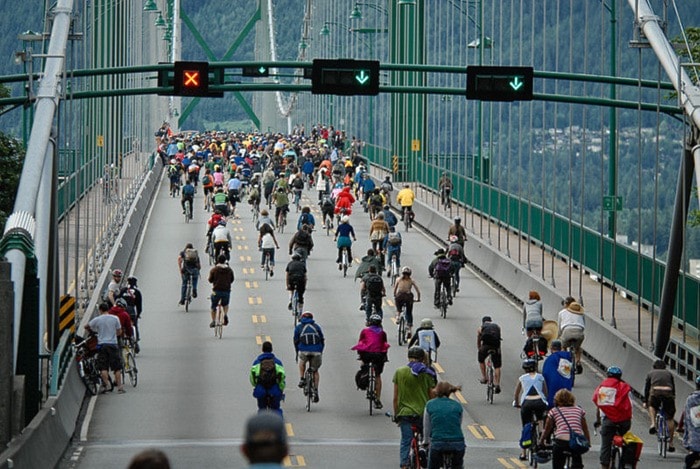Renovations of the next section of Lougheed, between 226th and 228th, have started.
Unfortunately, cyclists will not be getting what we had asked for: bike lanes on Lougheed through Maple Ridge’s town core.
The district feels that the widened sidewalks will adequately accommodate both pedestrians and cyclists, and wants to reserve the road space for the many cars that travel through our downtown. It wasn’t totally unexpected, but it was still disappointing.
If you want to encourage more cycling and less driving, you have to make cycling a more convenient and safe option, and it makes so much sense to make a shopping street like Lougheed more welcoming to people, including those on bikes. Studies have shown they might spend less on each visit, but they shop more often and tend to spend more overall than drivers.
I’m confident that eventually we will get our bike lanes, once gas prices have gone up sufficiently, and once Maple Ridge is ready for true Smart Growth.
I’m still hoping to see it happen once the Haney Bypass is widened.
We already have a pretty good idea of what to expect from these renovations. The width of the beautified and widened sidewalk on the north side of Lougheed between 223rd and 224th Streets is reduced because of garbage cans, benches, shrubs and plants, and numerous sandwich boards, and it’s difficult to pass pedestrians when you’re on a bike, so it’s not exactly an improvement for people on bikes.
At walking speed they are generally less well balanced and more likely to accidentally hit a pedestrian.
The narrower car lanes may make it even more intimidating to bike on the road, so I expect that there may be more sidewalk cycling.
HUB encourages people on bikes to be cautious when riding on the sidewalk, and to yield to pedestrians. Use your bell when approaching a pedestrian, and let the pedestrian know that you’re passing: “On your left!”
I would also like to remind drivers that people on bikes still have every right to be on the road.
Since the traffic lanes will be narrower than before, drivers will need to change lanes when passing a cyclist.
Sidewalk cycling usually happens because people don’t feel safe on the road, and you can’t really argue with people about their perception of safety. To a degree, people can gain more confidence by taking a cycling course. But having cars speed by, especially at close distance, is something that no cyclist appreciates.
In my experience, most drivers are polite and considerate, and some will stop for me even when they shouldn’. It’s much appreciated, but probably not a very good idea, because it can lead to confusion. There is, however, a small minority of drivers that can be extremely rude, and most people who bike on a regular basis have stories to tell of having pop cans thrown at them, being yelled at, or worse.
Drivers don’ t always understand why cyclists do certain things that may annoy them.
When there are cars parked on the road, we are taught to “take the lane”, which means: ride in the middle of the vehicle lane. This is to avoid “getting doored” when someone unexpectedly and without looking opens his car door in your face.
We don’t do these things just to annoy drivers.
When there’s a bike lane or shoulder, some drivers erroneously assume that people on bikes have no right to use the vehicle lanes. We do, and sometimes we need to, for example when there’s debris, a dangerous sewer grate or an illegally parked car on the bike lane, or when a bike lane is in the “door zone” of parked cars.
We’re all people. There are good and bad apples among both drivers and cyclists, and we should not single out a specific road user type when criticizing bad behavior.
In about half of all collisions involving cyclists, drivers and cyclists share the blame more or less equally.
Drivers need to keep in mind though that they’re in control of a dangerous killing machine and pedestrians and cyclists always lose big time in case of a collision, whether they’re at fault or not. So the onus is very much on the driver to control any irrational emotions of annoyance and anger, to slow down and drive responsibly. When you’re involved in a collision with a vulnerable road user, resulting in serious injury or death, in the end it really doesn’t make any difference if you were wrong or right.
Anyone is welcome to join our next bike ride on Sunday, Aug. 18, to Barnston Island. Start at Memorial Peace Park (at the southernmost Blue Fountain) at 8 am, or at 8:30 at the roundabout at Airport Parkway and Golden Ears Way on the Pitt Meadows side.
Total distance from Memorial Peace Park and back will be 50 km. All riders are responsible for their own safety.
Jackie Chow is with Maple Ridge-Pitt Meadows chapter of HUB.
A version of this column appeared in print on August 16, 2013, on page 26 in The News with the headline "Cyclists forgotten again in downtown".
